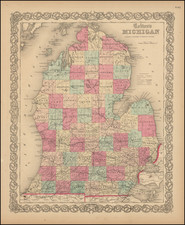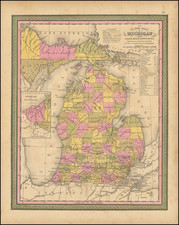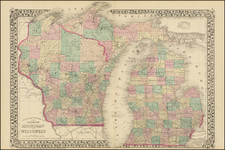With Extensive New Railroad Details
Rare railroad map of the State of Michigan, bearing the imprint of CW & GB Colton and dated 1874, but also issued by OW Gray in a special edition of his National Atlas.
The map is a revised and updated edition of Gray's Atlas New Railroad Map of Michigan, which includes extensive updates of existing routes, completion of proposed routes and signifcant new detail on the rail lines and rail stations in Michigan.
Michigan Railroads: Tracks of Progress and Industry
The history of Michigan railroads is a story interwoven with the state's own narrative of growth, prosperity, and industrialization. Beginning with Michigan's entrance into statehood in 1837, the development of railroads became essential in connecting its distant communities, boosting its economy, and establishing it as a vital component in the nation's expanding network of trade and transport.
Overview:
In the 1830s and 1840s, as settlements expanded beyond Detroit and its surroundings, there was a recognized need for faster and more reliable transport. The state's first rail line, the Erie & Kalamazoo Railroad, began operations in 1836, connecting Toledo, Ohio, to Adrian, Michigan. It was a simple line, and its horses were later replaced by steam locomotives. By the 1850s, more railroads had been built, linking cities like Detroit, Port Huron & Chicago Railroad, marking the onset of a grander vision for Michigan's rail connectivity.
Railroad Expansion in the 1870s and 1880s
The period of the 1870s and 1880s saw an accelerated pace of railroad construction in Michigan, driven in large part by burgeoning industries. The most prominent factor was the state's vast timber resources. Logging had become a colossal industry, and railroads were the most efficient way to transport logs to mills and then to markets outside of Michigan. Towns such as Manistee and Ludington grew in prominence due to their milling operations, and the railroads served as their lifelines.
Beyond timber, the discovery and mining of iron and copper in the Upper Peninsula necessitated a more robust rail network. Tracks snaked their way through the rugged terrains of places like the Marquette Iron Range, allowing raw materials to be shipped to manufacturing hubs like Detroit and then further afield to cities like Chicago or even eastward to the industrialized zones of Ohio and Pennsylvania.
Railroads also played a vital role in the state's agricultural expansion. As the lumber industry waned towards the end of the 19th century, farming began to play a more significant role in Michigan's economy. Railroads provided farmers with the means to send their products, such as grain, to distant markets, and this connectivity encouraged more agricultural activity.
Several key rail companies emerged during this period. The Michigan Central Railroad and the Grand Trunk Western Railroad, among others, expanded their networks substantially during these decades. Their routes not only crisscrossed the state but also connected Michigan to broader national and international markets.
The industrial surge in Michigan during the late 19th century provided the primary impetus for railroad expansion. As mentioned, the timber industry was a dominant force, with millions of acres of pine forests in the Lower Peninsula being cleared at an astonishing rate. The sheer volume of timber necessitated a transport system that could handle its bulk and weight, leading to a rapid construction of rail lines to and from logging areas.
Mining, too, was central. Iron ore from the Upper Peninsula was in high demand as America's industrial growth soared. Railroads were the most efficient way to move this heavy ore to furnaces in other parts of the state or beyond.
Lastly, the growth of Michigan's manufacturing base, especially in cities like Detroit, called for raw materials to be brought in and finished products to be sent out. Railroads played an indispensable role in this, solidifying Michigan's place in the nation's industrial heartland.
O. W. Gray was a publishing firm based in Philadelphia. Later, they published as O. W. Gray & Son. They published atlases in the late nineteenth century. Gray's National Atlas was one of the most successful commercial ventures of the 1870s and one of the last to employ hand coloring on maps.









![[ Michigan & 3 Great Lakes ] Amer. Sep. No. 42 Haut Canada Et Michigan](https://storage.googleapis.com/raremaps/img/small/98409.jpg)



![[ Detroit ] Sauer's Map of the City of Detroit and Environs, Michigan](https://storage.googleapis.com/raremaps/img/small/86145.jpg)
